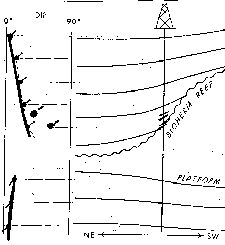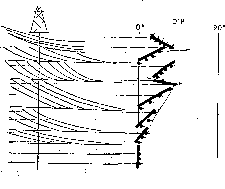|
 Deciding What The Patterns Mean
Deciding What The Patterns Mean
There are two basic ways to decide what red and blue patterns
mean from a stratigraphic point of view. The first is to sketch
a cross sectional view of the wellbore with the bedding planes
positioned according to the dipmeter data. Details of the sketch
are then compared to the sedimentary models, and the best choice
picked from the set of possible solutions.
The
second is to use a catalog or cookbook of typical patterns to
compare your pattern with those already described. As mentioned
earlier, regional dip removal can change a pattern, so the cookbook
approach is not too useful unless dip removal has been done. Both
methods require the use of gamma ray or SP curve shapes and energy
level estimates, as described above, to distinguish between various
models which may have similar patterns.
To
draw a sketch of dipmeter data, take a piece of graph paper, blank
well log paper, or a photocopy of the dipmeter arrow plot itself.
A log at 1 to 240 (5 inches per 100 feet) scale is suitable for
stratigraphic analysis. To save effort later, it will be helpful
to splice on a copy of the gamma ray or SP log if it does not
already appear on the dipmeter. More detailed scales may be needed
to analyze GEODIP or DUALDIP logs, such as 1:40 or 1:20.
On
a clear area of this montage, or on your graph paper, draw a vertical
line to represent the wellbore. If the well is deviated, draw
the line at this angle. Note that dip angles on a dipmeter are
relative to vertical, so keep your dipping beds relative to the
vertical, even if the well is deviated.
Select
the interval you wish to analyze and mark some depth lines to
orient your data. Transfer the position of the black patterns
to your sketch. These represent breaks in the geologic sequence,
such as unconformities or sedimentary structures. Use the gamma
ray curve or a computed lithology log and the well history data
as guides to major erosional surfaces and the location of sedimentary
structures.
Next,
choose regional dip in each major rock unit and draw short hash
marks on the wellbore at an angle representing the actual dip
shown on the log. Some vertical exaggeration may be appropriate.
At this point you have to decide on the direction of cross section
that your sketch will represent. For example, if regional dip
is to the northeast, the cross section should run from southwest
to northeast.
Next
position representative samples of the dip from the blue and red
patterns onto your sketch. You are really creating your own stick
plot. For stratigraphic analysis, it always helps to sketch the
curve shape from the gamma ray log (if you are not working on
a copy of the log itself) to define which of the three major sedimentary
structures are present, regressive sands (funnel shaped - coarsening
upward), transgressive sands (bell shaped - fining upward), or
high energy (cylindrical - constant grain size).
Now
comes the hard part. Extend the hash marks to represent the bedding
planes of a sedimentary structure. You are only dealing with a few sedimentary
models, which are described below. Each model should be reviewed
for its characteristic curve shapes and dipmeter patterns, then
you can draw a rational interpretation of the dip patterns.
  
Sketching dipmeter data for comparison
to sedimentary models
Over
the years, I have found that only a rare few individuals have
the gift to remember the patterns without aids, such as the service
company catalogs of patterns, or the descriptions contained in
this Handbook. Be sure to be familiar with the regional geology,
the well history data, sample descriptions, and known sedimentary
structures in the areas before proceeding.
Much
has been done in the last 20 years to improve both the dipmeter
tool and the data processing capability to provide more detailed
descriptions of bedding, lithofacies, and depositional environment.
For example, Schlumberger's GEODIP or DUALDIP programs, followed
by the SYNDIP program, can use dip data taken at the rate of 60
samples per foot from the Stratigraphic High Resolution Dipmeter
(SHDT) and output 1.2 inch results showing dip angle and azimuth,
bedding plane linearity, depositional environment, and interpreted
lithology. This is done by creating synthetic logs, using principal
component analysis, from such things as dip frequency, dip density,
dipmeter resistivity curve activity, the ratio of the thickness
of positive peaks to negative peaks, and sharpness of the curves.
Comparison
of these new techniques with standard high resolution dipmeter
data is startling; the enormous detail available is almost overwhelming
and boggles the mind of most mortals. An example is shown in
below. Note that the depth lines are 0.4 meters (a little more
than a foot) and that rational red and blue patterns can be seen
spanning distances of less than 6 inches! To display this much
information, depth scales of 1 to 40 (30 inches per 100 feet)
or 1 to 24 (50 inches per 100 feet) are recommended, reminiscent
of the 1 to 48 scales used in the distant past for micrologs and
microlaterologs. Dip frequency azimuth plots from such data give
much stronger statistical evidence of stratigraphic features.

Comparison of resolution of various dipmeter
processing methods
|

